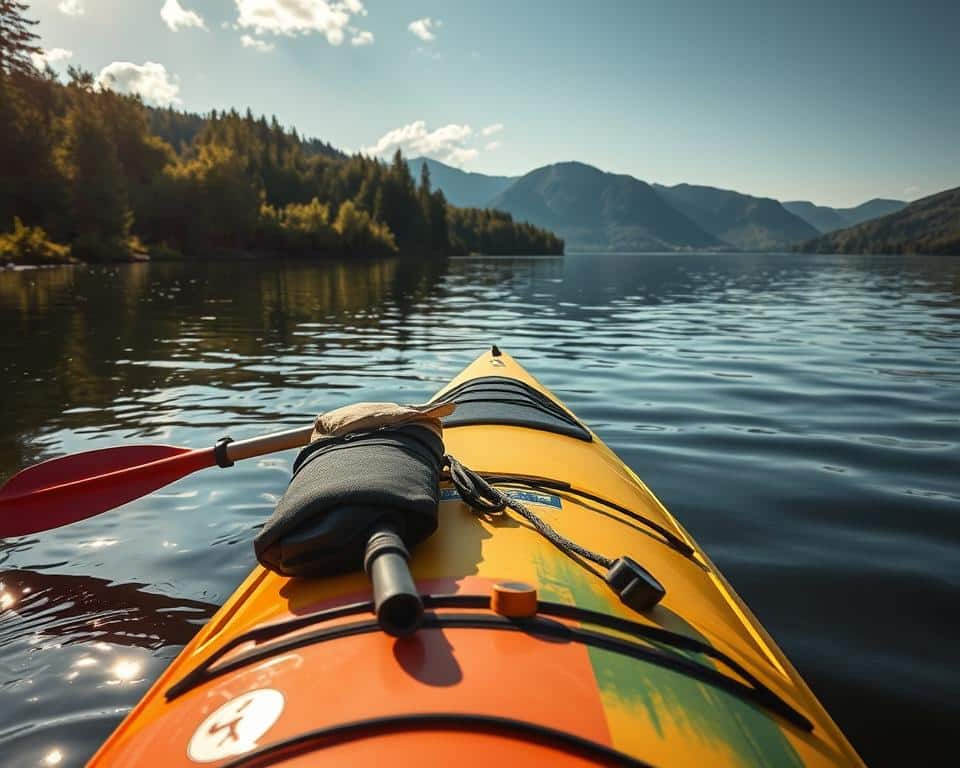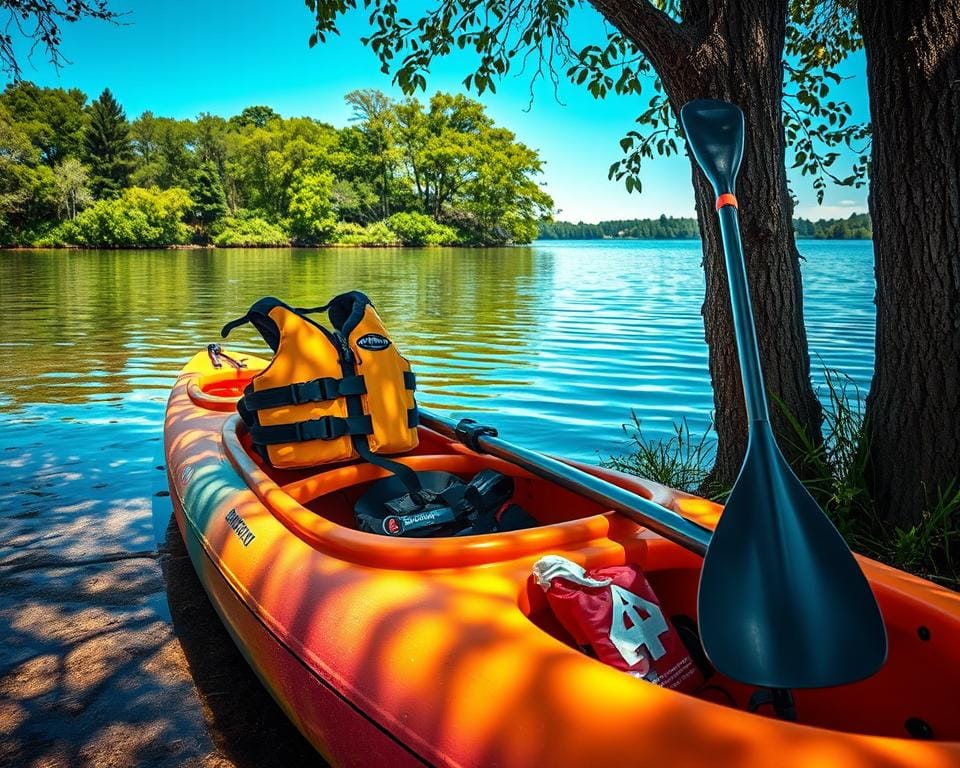Stepping into kayaking links you with nature in a deep, thrilling way. Yet, it’s key for beginners to grasp safety tips. Blazin’ Paddles in Las Vegas is a great start. They focus on safety and fun during their guided tours.
Choosing the right gear is an early step for newbie kayakers. You must wear a life jacket. It’s not just a rule but it can save your life. On calm ponds or rough rivers, a Personal Flotation Device (PFD) is a must.
But there’s more to prep than just a life jacket. It’s vital to check the weather as it can change your safety plans. Having a first aid kit and ways to communicate, like a waterproof phone case, is smart.
Don’t forget sun protection and a hat. Also, dry bags are great for keeping things safe. These outdoor kayaking essentials boost your fun and safety.
Starting kayaking the right way makes your adventure exciting and safe.
Understanding the Basics of Kayaking
Starting kayaking is exciting, but knowing the basics is crucial for safety and fun. You need to learn about choosing kayaks, the best kayaking posture, and how sit-on-top kayaks differ from sit-inside kayaks.
Choosing the Right Kayak
Finding the perfect kayak depends on what you like and where you’ll paddle. For rivers, a short, wide river kayak works best because you can turn easily. If you’re into sea kayaking, choose a longer, narrow kayak. It’s great for distance and has a rudder or skeg for stability in open water.
Also, check out River Queen Voyages for awesome tandem kayaks. They’re great for paddling with a buddy and have shining 5-star reviews.
Proper Sitting Posture and Paddling Techniques
Good sitting posture in a kayak makes paddling comfortable and safe. Sit up straight, bend your knees a bit, and snug your hips into the seat. Use foot pegs to keep your feet steady. This helps with balance and makes your paddling stronger. Staying in this posture also cuts down on tiredness and makes you paddle better.
Types of Kayaks: Sit-on-Top vs. Sit-Inside
When picking out a kayak, choosing between a sit-on-top kayak and a sit-inside kayak is key. Sit-on-top kayaks are stable and easy for beginners. If you tip over, getting back on is simple. But, sit-inside kayaks shield you more from wind and water. They’re good for cold or rough water conditions.
- River Kayaks: Wider, more stable, perfect for moving waters.
- Sea Kayaks: Longer, narrower, designed for open waters and often equipped with storage and navigation aids.
Learning these basics sets you up for exciting and safe kayaking. Whether you’re looking for a calm day on a lake or an ocean adventure, knowing this info helps make your trip great.
The Importance of Essential Safety Gear
Staying safe on the water means you need the right kayaking gear. Every piece is important for a good kayaking experience. Knowing why each item matters can make your trips safer and more fun.
Personal Flotation Devices (PFDs)
For kayakers, a Personal Flotation Device (PFD) is a must-have. It’s your lifeline if you fall into the water. Your life vest should be snug but not tight, allowing you to breathe and move freely. Always pick a PFD approved by the US Coast Guard to meet safety expectations.

Choosing the Right Paddle
Choosing the right paddle is key to both safety and performance. Your paddle length should match your height and kayak’s width. Go for carbon fiber paddles; they’re light, making steering easier and less tiring.
Additional Gear: Dry Bags, Bilge Pumps, and More
Your kayaking kit should have more than just the basics. Dry bags keep your stuff dry, no matter the weather. Bilge pumps are crucial for getting rid of any water in your kayak, keeping it stable and afloat. Polarized sunglasses protect your eyes from glare on the water. And don’t forget quick-dry clothes and UV protection for comfort and safety.
Include the Manta Racks L2K System in your gear, too. It helps you safely transport your kayak. This lets you try out new and distant places to paddle with ease.
| Essential Gear | Function |
|---|---|
| Personal Flotation Device (PFD) | Provides buoyancy and keeps the kayaker afloat in the water. |
| Kayaking Paddles | Facilitates effective movement through the water. |
| Dry Bags | Keeps personal items dry and protected. |
| Bilge Pumps | Removes water that has entered the kayak. |
| Polarized Sunglasses | Reduces glare and protects the eyes. |
| Quick-Dry Attire | Enhances comfort by quickly wicking moisture away from the body. |
Weather and Environmental Awareness
Planning a kayaking trip? Don’t forget about the weather. It’s not just about checking today’s forecast. You must also think ahead about changes that might happen. So, getting detailed weather updates and having a backup plan is key to your safety.
Checking Weather Conditions
Always look at several weather reports before you go. Weather can change fast, changing your kayaking plans too. For example, in places like Big Sur, the weather can shift quickly. You might face strong winds, fog, or big waves. Knowing these patterns helps you prepare and maybe change your plans.
Understanding Water Conditions and Hazards
Understanding what’s in the water is just as important. This means knowing how cold the water is, how strong the current is, and what obstacles you might find. Beginners especially need to pay attention to this. It could be the difference between a fun time and a dangerous one. A great resource is the Water Safety Guide. It has lots of tips for safer kayaking.
In rivers like the San Antonio, it’s vital to know about the water flow and current weather. Dressing right, like wearing long sleeves, can protect against sunburn. And shoes? They keep your feet safe from things on the riverbed if you flip over.
Wildlife Awareness and Respect
Respecting wildlife is a big part of kayaking. In places like Big Sur, you’ll see seals, sea lions, otters, birds, and whales. Understanding their habits not only makes your trip more interesting. It also helps protect their homes. Marine reserves have rules to keep nature safe, which helps everyone, including the animals.
So, whether you’re just starting or have been kayaking for years, remember this. Being aware of the weather, water hazards, and wildlife is essential for a safe, enjoyable time on the water. Make sure you’re ready with the right knowledge and gear for whatever comes your way.
Skills and Training: Your Safety Net
Learning how to stay safe while kayaking boosts my readiness for surprises on the water. By taking paddling classes, I better my skills. I focus on mastering the power stroke and using my body right.
Knowing how to rescue myself is key. This skill means I can quickly handle a kayak flip. Also, regular safety training teaches me how to keep safe and have more fun.
Float the River offers great kayaking experiences for all skill levels. They provide solo and group trips which make picking what to do easy. They focus on helping beginners feel at ease while learning.
Choosing the correct gear is another critical point in kayaking safety training. Picking the right life jacket and using specialized equipment like fiberglass paddles makes a big difference. It prepares me for various kayaking situations.
Staying low in the kayak and managing windy conditions are advanced techniques. Learning these in paddling classes helps improve my kayaking. It also makes my time on the water safer.
Emergency Protocols Every Kayaker Should Know
Being ready for emergencies is key when kayaking. Knowing how to ask for help, rescue techniques, and having a good float plan are important. Let’s go over these key safety steps every kayaker should follow.
How to Signal for Help
It’s vital to know how to signal for help quickly. Every kayaker needs a whistle to draw attention. Flares or marine VHF radios also help greatly. Make sure you can get to these tools easily and they work well.
Basic Water Rescue Techniques
Knowing how to rescue yourself or others is crucial. Using throw bags or ropes helps you save others safely. It’s important for every kayaker to learn techniques like T-rescue or using a paddle float. Saving lives starts with learning these skills.
Creating and Filing a Float Plan
Always file a float plan before heading out. Include who’s going, your route, return time, and who to contact in an emergency. Sharing this plan makes it easier for rescuers if you don’t return as planned.
| Emergency Item | Purpose |
|---|---|
| Whistle | Signal for Help |
| Marine VHF Radio | Emergency Communication |
| Throw Bags | Perform Rescues |
| Personal Locator Beacon (PLB) | Location Tracking |
Following these steps makes kayaking adventures much safer. Being ready for emergencies makes trips safer and more fun for everyone, whether you’re new or experienced.
Kayaking Safety Guidelines
Staying safe while kayaking means following certain rules. These rules are key for new and advanced kayakers alike. They help everyone have a good time on the water safely. Here are some important tips for kayakers.
Never Paddle Alone: The Buddy System
Kayaking alone, especially in unknown places, is risky. The kayaking buddy system is a big help. It means you look out for each other. If trouble pops up, your buddy is there to help quickly. Going solo might sound fun, but it’s safer with a friend.
Dressing Appropriately for Conditions
Picking the right clothes is crucial for kayaking safely. Wrong clothing choices lead to many kayaking accidents. Whether it’s hot or cold, choosing the right gear, like moisture-wicking or insulating layers, matters. Also, don’t forget sun protection to avoid heat stroke.
Avoiding Alcohol and Paddling
Avoiding alcohol is a top kayaking safety rule. Boating while drunk ups the chance of accidents. Alcohol messes with your judgment and reflexes, which are vital for kayaking. Stay sober to keep safe and protect others on the water.

Following these safety tips makes kayaking more enjoyable and much safer. Whether it’s choosing the right gear, paddling with a buddy, or avoiding booze, each safety step is important. Be smart and prepared for amazing kayaking trips.
Conclusion
Kayaking journeys change how we see nature, making every paddle stroke exciting. It’s key to stay safe while having fun. That means choosing the right kayak for your needs. Whether it’s a sit-on-top for warm oceans or a sit-in for the cold. Knowing your gear well makes kayaking better and safer.
Having the right safety gear is crucial in kayaking. By law, everyone needs a USCG-approved life jacket on board. And kids 13 and under must wear theirs all the time. It’s important to have life jackets that fit right and to bring a waterproof first aid kit. You should also know how to call for help and have a plan in case of trouble. These steps make your trip safer and more pleasant.
Before going kayaking, always check the weather and water. Nature can surprise you, and being ready makes a big difference. Kayaking with others can also make your trip safer. When you follow these tips, your journey is not just safer but better too.
When you combine safety with excitement in kayaking, you get the best of both worlds. Listen to experts and know your tools to enjoy the water safely. Learning how to stay safe in different waters is important. Check out how to know if water is for more info. Your kayaking trips will fill your life with unforgettable moments, adding to your adventure stories.

